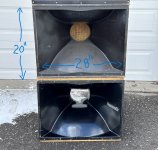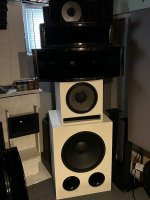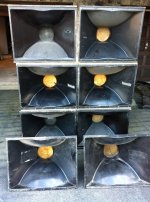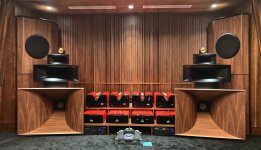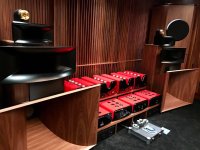Getting started on a midbass horn for use with my A290s. I have some thoughts on the midbass enclosure design I'd like to clear up with some of you horn experts. Hornresp would probably answer this for me, but at the moment, the software wont open properly for me without errors.
While calculating the WG profile, I was curious (hoping) if the throat surface area appropriate for a single LF driver could be simply assumed to double when adding a second identical driver? Does this also potentially shorten the total WG length?
In my case, 2 x B&C 12MH32s per side were planned for use in a FLH design similar to Inlow spec FL midbass horn. I was initially going to use a single 12PE32 per side, but started thinking about trying the altec A7 expo-reflex design instead. This brings me to the next potential issue, given the lack of rear chamber on the A7 screwing up the WGs performance. In the past, I've only built FLHs with reactance annuling rear chambers, not with the reflex rear enclosure setup of the A7. I'd imagine the transient response of a well designed traditional FLH would go south with the expo-reflex design, as most RLHs with 1/4 wave TLs would have similar issues not having any reactance annuling.
The 12MH32 requires a smaller throat entry surface area than the 12PE32, so my theory of doubling the total throat entry surface of a dual LF driver horn would allow for a shorter horn length, assuming this would be like starting the WG profile at a larger throat surface area entry point and ending at the same 1/2 - 1/4 pi mouth area? Is my theory correct on this, or am I just being misled by my morning dose of meds?
While calculating the WG profile, I was curious (hoping) if the throat surface area appropriate for a single LF driver could be simply assumed to double when adding a second identical driver? Does this also potentially shorten the total WG length?
In my case, 2 x B&C 12MH32s per side were planned for use in a FLH design similar to Inlow spec FL midbass horn. I was initially going to use a single 12PE32 per side, but started thinking about trying the altec A7 expo-reflex design instead. This brings me to the next potential issue, given the lack of rear chamber on the A7 screwing up the WGs performance. In the past, I've only built FLHs with reactance annuling rear chambers, not with the reflex rear enclosure setup of the A7. I'd imagine the transient response of a well designed traditional FLH would go south with the expo-reflex design, as most RLHs with 1/4 wave TLs would have similar issues not having any reactance annuling.
The 12MH32 requires a smaller throat entry surface area than the 12PE32, so my theory of doubling the total throat entry surface of a dual LF driver horn would allow for a shorter horn length, assuming this would be like starting the WG profile at a larger throat surface area entry point and ending at the same 1/2 - 1/4 pi mouth area? Is my theory correct on this, or am I just being misled by my morning dose of meds?
"Appropriate" needs to be defined in terms of bandwidth, acoustical transformation gain, harmonic distortion, polar response and other parameters.While calculating the WG profile, I was curious (hoping) if the throat surface area appropriate for a single LF driver could be simply assumed to double when adding a second identical driver?
Yes, at the expense of acoustic gain.Does this also potentially shorten the total WG length?
The A7 horn is similar to the JBL 4560, provides ~ +5dB gain from ~200-800Hz.In my case, 2 x B&C 12MH32s per side were planned for use in a FLH design similar to Inlow spec FL midbass horn. I was initially going to use a single 12PE32 per side, but started thinking about trying the altec A7 expo-reflex design instead.
If you are thinking of the Inlow mid-bass horn, very different both in terms of
gain (around +10dB), dispersion and transient response.
I don't understand why you suggest that a driver with higher power handling, higher BL, more excursion with the same Sd and similar cone weight would "require" a a smaller throat entry, but doubling the total throat entry area can allow for a shorter, less efficient horn.The 12MH32 requires a smaller throat entry surface area than the 12PE32, so my theory of doubling the total throat entry surface of a dual LF driver horn would allow for a shorter horn length, assuming this would be like starting the WG profile at a larger throat surface area entry point and ending at the same 1/2 - 1/4 pi mouth area?
What are your desired crossover frequencies, dispersion and size restrictions?
Art
@weltersys Art to the rescue! I should have defined BW before hand. Looking at the Inlow horn, which sounds very good BTW, it would fulfill the need but looking at a potential benefit from the A7 type design, I like the extended low end potential with EQ or assisted alignment.
I'd prefer the cleaner sound of the Inlow FLH and would rather add a sub. I don't need a ton of gain but roughly 100hz +, up to the A290 HP around 450 to 500 hz. I'd prefer to shorten the horn with help of the 2 x 12MH32, which I already have on hand. That was my goal over a single 12PE32. I have up to just under 30" enclosure depth to work with. Not sure if that's possible with the Inlow horn, even with the extra driver per side allowing a shorter horn.
I'd prefer the cleaner sound of the Inlow FLH and would rather add a sub. I don't need a ton of gain but roughly 100hz +, up to the A290 HP around 450 to 500 hz. I'd prefer to shorten the horn with help of the 2 x 12MH32, which I already have on hand. That was my goal over a single 12PE32. I have up to just under 30" enclosure depth to work with. Not sure if that's possible with the Inlow horn, even with the extra driver per side allowing a shorter horn.
Short depths require some bending. The old Martin MH-212 "Phillishave" was an early example, but didn't make much below 250Hz:I have up to just under 30" enclosure depth to work with. Not sure if that's possible with the Inlow horn, even with the extra driver per side allowing a shorter horn.
You could base a design on the EV MTH horns, 30" cabinet depth, using a side entrance phase plug and reflector to extend the dual driver horn throat.
The MTH 2/94 response looks a bit better for your application:
The sensitivity would be near the A290s, a 2x12" could easily outrun it at 500Hz.
https://patentimages.storage.googleapis.com/fc/55/30/82c9d896407c69/US4718517.pdf
I've used a similar simple phase plug on EVX 150 15" with an 800 Hz crossover, even a random passerby my trailer shop could tell it sounded better "with" than without.
Dave Gunness went on a step from Dave Carlson's patent invention with his "Oculus" compression head:
For a 500 Hz crossover, that level of detail in the Oculus isn't needed, but the extra turn adds more horn length, it could get closer to 100Hz in a 30" depth.
Art
Last edited:
@weltersys Thank you Art! That's really what I needed to know. I'd think the extra height of dual 12s would tighten the directivity vertically, but that would be more of a welcomed bonus than outright requirement. The 1k vertical pattern flip of the A290 horn is a bit of a nuisance. I think the midbass horn won't have any issue blending with it being properly time aligned.
Calculatiing the throat entry and using what is practical vs mathematically perfect is something I'll wrestle with. The 12MH32s are shallow drivers, about the depth of 12PE32s or similar ie JBL 2206.
Would it be better to put them in separate chambers rather than a single larger one? Last time I sort of ball park calculated the chamber vol, the result was a very small chamber. That's honestly why I wanted a pair of higher power drivers than a single midbass with a 65mm VC, like the 12PE32. I doubt they'll be pushed that hard being in a home audio environment, but on occasion I do listen quite LOUD every once in a while and sometimes re-recording drums through PA.
How critical is the phase devider between the drivers? I'd think good phase plugs would do enough of a job. The mouth circumference would end up at 9-10 ft. How much would a single smooth 90 degree turn hurt the top end cutoff? That would permit a more shallow enclosure. I was also intending to run a rectangular throat opening with a simpler phase slot. I'll take a close look at the pictures you posted, which are extremely helpful.
Do you recommend any easier way or specific software to calculate the WG profile? I wish Hornresp was behaving for me.
Out of curiosity, do you know of a more sure fire accurate way to calculate both volume elements of the rear ported reflex horns? I just don't know if they'll perform that well on the low end, making them a waste of time considering their use. How big would the mouth have to be for an 80 hz cutoff with a 2 pi radiation boundary?
Calculatiing the throat entry and using what is practical vs mathematically perfect is something I'll wrestle with. The 12MH32s are shallow drivers, about the depth of 12PE32s or similar ie JBL 2206.
Would it be better to put them in separate chambers rather than a single larger one? Last time I sort of ball park calculated the chamber vol, the result was a very small chamber. That's honestly why I wanted a pair of higher power drivers than a single midbass with a 65mm VC, like the 12PE32. I doubt they'll be pushed that hard being in a home audio environment, but on occasion I do listen quite LOUD every once in a while and sometimes re-recording drums through PA.
How critical is the phase devider between the drivers? I'd think good phase plugs would do enough of a job. The mouth circumference would end up at 9-10 ft. How much would a single smooth 90 degree turn hurt the top end cutoff? That would permit a more shallow enclosure. I was also intending to run a rectangular throat opening with a simpler phase slot. I'll take a close look at the pictures you posted, which are extremely helpful.
Do you recommend any easier way or specific software to calculate the WG profile? I wish Hornresp was behaving for me.
Out of curiosity, do you know of a more sure fire accurate way to calculate both volume elements of the rear ported reflex horns? I just don't know if they'll perform that well on the low end, making them a waste of time considering their use. How big would the mouth have to be for an 80 hz cutoff with a 2 pi radiation boundary?
At 500Hz, a phase plug is not critical.How critical is the phase devider between the drivers?
Won't hurt it at all if properly done. That said, reducing upper cone break-up is a good thing.How much would a single smooth 90 degree turn hurt the top end cutoff?
Before discovering Hornresp, I used the back of envelopes 😉 .Do you recommend any easier way or specific software to calculate the WG profile? I wish Hornresp was behaving for me.
Hornresp has been working fine on my Mac, using Wine Version 1.8.6
Ackabak might be more accurate than Hornresp, but I don't know anything about operating it.Out of curiosity, do you know of a more sure fire accurate way to calculate both volume elements of the rear ported reflex horns?
Depends on how much ripple you are willing to tolerate.How big would the mouth have to be for an 80 hz cutoff with a 2 pi radiation boundary?
Slightly better, but I don't think I'd be able to hear the difference.Would it be better to put them in separate chambers rather than a single larger one?
That said, if the drivers are on opposite sides of the cabinet, no reason not to make individual chambers.
The phase plug isn't that difficult to design using the driver's cone as a mold. Some plastic wrap over the cone to protect it and epoxy resin will make a perfect copy of the cone profile. The passage ways through the phase plug can be duplicated using foam wedge inserts.
The first 1/2 WL bell breakup mode on a 12" cone driver is roughly 800 hz. It should be good to 1000 hz with a good phase plug design according to my basic calculations.
The first 1/2 WL bell breakup mode on a 12" cone driver is roughly 800 hz. It should be good to 1000 hz with a good phase plug design according to my basic calculations.
Last edited:
@profiguy do you have any preliminary dimensions in mind of what you plan on building? I'd like to try something similar for my next project.
2 x 2206 per side (target 75Hz-500Hz) in an expo-reflex design underneath large radial horns. I have 4 x 2206H and a pile of Community M80 horn flares but the rear compression caps included are extremely small for a 12" driver. The M80 flares are 28" W x 20" H x 14" D. Tried 1 x 2206 with compression cap full of denim insulation and measured approximately 160Hz-550Hz usable range, 2206H doesn't have rising response but could integrate OK at 500Hz.
I want to try vertical double stack, build vented rear chambers and perhaps add large extension mouth on front. Goal is to extend low end by one octave. Not sure about my HornResp parameters but was going to start with 32L (1.13 cu ft) chamber tuned to 75Hz.
How important is angle of side walls? The M80 flares are 60 degrees but my 2" and 1" horn are 90 degrees. Another reason why I was thing of adding extension mouth or barn doors. I'm new to building midbass horns but not afraid to make some dust and learn along the way.
2 x 2206 per side (target 75Hz-500Hz) in an expo-reflex design underneath large radial horns. I have 4 x 2206H and a pile of Community M80 horn flares but the rear compression caps included are extremely small for a 12" driver. The M80 flares are 28" W x 20" H x 14" D. Tried 1 x 2206 with compression cap full of denim insulation and measured approximately 160Hz-550Hz usable range, 2206H doesn't have rising response but could integrate OK at 500Hz.
I want to try vertical double stack, build vented rear chambers and perhaps add large extension mouth on front. Goal is to extend low end by one octave. Not sure about my HornResp parameters but was going to start with 32L (1.13 cu ft) chamber tuned to 75Hz.
How important is angle of side walls? The M80 flares are 60 degrees but my 2" and 1" horn are 90 degrees. Another reason why I was thing of adding extension mouth or barn doors. I'm new to building midbass horns but not afraid to make some dust and learn along the way.
Attachments
@AE13 Wow, looks like you bought out someone's PA there. I used some of those flares in a large club many eons ago. They need alot of EQ to smooth out with most typical drivers, plus they have a considerable amount of ripple and need more WG depth for their intended cutoff. I'll have to do more math and get back to you on the rest of my plans. Lots to think about here...
Forgot to mention, my intended WG depth is just over 30 inches with the chamber for the straight profile. I don't think you'd get away with less than that for a < 100 hz cutoff unless you're ok with more ripple. Art mentioned a dual driver version with a turned profile using a sideways turned manifold. I'm looking at a 10ft mouth circumference for a 80 hz cutoff in a 2 pi field. The throat area for one driver is around 125 cm^2.
🙂 100% bang on ... I did buy out retired PA guy's garage full of old Community Light and Sound horns and flares. Price was very fair and gave me lots to experiment with at home. The large radial horns were a complete game changer in my setup. This DIY journey led me to understand I prefer the sound of large format horns vs smaller modern horns/waveguides. I can try to build anything as long as I can fit it through a doorway and bring downstairs to basement (aka man cave). Interested to see how your plans evolve.
Throat on the M80 is 7" diameter, which I believe equates to a low compression ratio. Considering about 14ft mouth circumference (3ft W x 4.6ft H). From lurking around various horn threads I recognize the depth of the M80 was a limiting factor for my target range.
It's my understanding that M80 with EVM12L was used from 150-300Hz up to 1000-1200Hz back in the day.
Viva Audio Master Horn is the current inspiration. Midbass horn appears to be about 30"-36" deep (mouth to throat).
Throat on the M80 is 7" diameter, which I believe equates to a low compression ratio. Considering about 14ft mouth circumference (3ft W x 4.6ft H). From lurking around various horn threads I recognize the depth of the M80 was a limiting factor for my target range.
It's my understanding that M80 with EVM12L was used from 150-300Hz up to 1000-1200Hz back in the day.
Viva Audio Master Horn is the current inspiration. Midbass horn appears to be about 30"-36" deep (mouth to throat).
Attachments
A 4 way horn system is ambitious. The EVM12L was the go to driver for alot of horn guys. It had the right specs for a typical FLH and actually sounded decent from a hifi perspective once horn loaded. Bruce Edgar was also a big fan of the 12L which says alot about it.
The 12PE32 is quickly becoming (pr already is) the usual go to modern driver for FLHs. However, it has one big drawback. Theres a nasty spider resonance at 550hz, which I physically verified using that new Dayton Audio AS1 speaker strobe light. It took 75w of input into the driver in free air (and ear muffs) to get enough excursion to see it with the naked eye using the strobe light. The 12MH32 doesn't have that issue, but it also doesn't have the 12PE32s extended upper cutoff. Spider resonances are tricky, as they don't always show up in the driver FR the same way. Usually you get a peak in the impedance witbout any apparent cone breakup. Thats usually the giveaway your dealing with a suspension related resonance.
As to overall dimensions, my main criteria is depth. I should have enough width for 100 hz cutoff.
The 12PE32 is quickly becoming (pr already is) the usual go to modern driver for FLHs. However, it has one big drawback. Theres a nasty spider resonance at 550hz, which I physically verified using that new Dayton Audio AS1 speaker strobe light. It took 75w of input into the driver in free air (and ear muffs) to get enough excursion to see it with the naked eye using the strobe light. The 12MH32 doesn't have that issue, but it also doesn't have the 12PE32s extended upper cutoff. Spider resonances are tricky, as they don't always show up in the driver FR the same way. Usually you get a peak in the impedance witbout any apparent cone breakup. Thats usually the giveaway your dealing with a suspension related resonance.
As to overall dimensions, my main criteria is depth. I should have enough width for 100 hz cutoff.
A 2x12" response can be quite good with no phase plug to 800Hz as can be seen in my 1979 PA system chart.The phase plug isn't that difficult to design using the driver's cone as a mold.
The first 1/2 WL bell breakup mode on a 12" cone driver is roughly 800 hz. It should be good to 1000 hz with a good phase plug design according to my basic calculations.
The drivers were the original 1970s EVM 12L series, which were rated for 100 watts sine wave, but +3dB sensitivity over the 200 watt 1980s 12L Series II, and later "300 watt" (EIA RS-426-A 1980) 100dB 1/w 1m.
I still remember when the power rating doubled, but the sensitivity went down by -3dB, but can't find a spec sheet...
The chart shows flat on-axis (green) response from 170Hz to 800Hz, measured at 4 feet.
1/w 1m sensitivity is over 107dB.
The red line is measured 45 degrees off axis, -7dB@800Hz with the drivers oriented vertically, horizontal dispersion.
The blue line is the vertical dispersion, -12dB@800Hz.
The 2x12" low mid cabinets measured in the above chart external dimensions are 45" x 22.5" x 30" depth.
The horn throat exit is ~5.75" wide x 11" tall.
The horn depth to the speaker baffle ~22".
Art
@weltersys That's quite the impressive large format setup for 70s standards and even compared to today's cookie cutter line arrays, most of which don't sound nearly as good as some of the better horn systems available back then. You had to work harder to get sensitivity, making up for at the time limited amplifier output. I'm sure pushing 100 watt drivers that hard in a small sealed chamber required some power derating for reliability sake.
The 2 x 12 info looks very good for a non phase plug equipped design! I would have been happy with less bandwidth back in the 80s designing large FLHs in night clubs just for dance music. 107 dB is nothing to sneeze at given the simple design. The 100 - 1k range is likely the most critical area to get right on a good PA. Very often it would be covered by direct radiators in smaller systems. It proves here you dont need monstrous cabs to achieve excellent midrange performance down to the low 100s hz area. I would have in fact settled for a 2 x 12 direct radiating enclosure to cover the low mids, but it shows you can easily get there with a 2 x 12 FLH, considering how short the flares were.
Do you happen to know the type of flare profile used in the examples you posted? I'd assume they were exponential, being an older design.
The 2 x 12 info looks very good for a non phase plug equipped design! I would have been happy with less bandwidth back in the 80s designing large FLHs in night clubs just for dance music. 107 dB is nothing to sneeze at given the simple design. The 100 - 1k range is likely the most critical area to get right on a good PA. Very often it would be covered by direct radiators in smaller systems. It proves here you dont need monstrous cabs to achieve excellent midrange performance down to the low 100s hz area. I would have in fact settled for a 2 x 12 direct radiating enclosure to cover the low mids, but it shows you can easily get there with a 2 x 12 FLH, considering how short the flares were.
Do you happen to know the type of flare profile used in the examples you posted? I'd assume they were exponential, being an older design.
The 1979 fiberglass 2x12" low mid (and the 2x15") in post #13 were exponential horns.


The top, bottom and center divider sections were flat pieces other than the fillets around the speakers.
The left and right exponential curves could be approximated with two straight sections, as in the second picture above. The two conical sections are nearly equivalent to the expo, no bending required.
The top, bottom and center divider sections were flat pieces other than the fillets around the speakers.
The left and right exponential curves could be approximated with two straight sections, as in the second picture above. The two conical sections are nearly equivalent to the expo, no bending required.
@weltersys For playback at home, what are your thoughts on venting that same 2 x 12" low mid to reach an octave lower?
Using the available cabinet volume, venting that same 2 x 12" low mid would result in a stepped response similar to the JBL 4560 in post #2.
The low end provided by the bass reflex would be around 6 dB lower than the response above 150Hz.
The range between around 1/3 octave above Fb (box tuning) and the horn's Fc of ~150 Hz would not have near the headroom as above. If equalized to "keep up" the excursion required below Fc would modulate the midrange at high SPL.
If a higher SPL isn't required, neither are horn low mids.
The low end provided by the bass reflex would be around 6 dB lower than the response above 150Hz.
The range between around 1/3 octave above Fb (box tuning) and the horn's Fc of ~150 Hz would not have near the headroom as above. If equalized to "keep up" the excursion required below Fc would modulate the midrange at high SPL.
If a higher SPL isn't required, neither are horn low mids.
Thanks for that @weltersys. Point taken. I don't want to run my subs up to 150Hz, not even 90Hz. IMO the 2206's handle that range much better in my room. Introducing a 6dB dip where my house curve currently rises doesn't "sound" appealing. The M80 flares will remain in the garage for a future project that is more geared towards their sweet spot (above Fc).
@weltersys Thank you again for your time and help with this. Would it be correct to assume the back chambers on these horns were all relatively small? Is there anything to gain going through the hassle of transitioning and smoothing the corners of the throat entry into the WGs? Would it be correct to think adding fillets between the driver throats would help with vertical dispersion?
I'd rather use separate vented subs with these horns than try to integrate the LF into them by just venting the backs, compromising their performance as dedicated midbass enclosures. I'd think the effects of IM distortion caused by BL fluctuation would be magnified even more using the driver in a horn compared to direct radiating. Some BLHs I've heard has this issue compared to straight up vented direct radiating enclosures.
I'd rather use separate vented subs with these horns than try to integrate the LF into them by just venting the backs, compromising their performance as dedicated midbass enclosures. I'd think the effects of IM distortion caused by BL fluctuation would be magnified even more using the driver in a horn compared to direct radiating. Some BLHs I've heard has this issue compared to straight up vented direct radiating enclosures.
Last edited:
The back chamber shared by the two 12" drivers was ~80 liters, not very small.Would it be correct to assume the back chambers on these horns were all relatively small?
The later generations of horns we built used no corner fillets and all straight plywood sections.Is there anything to gain going through the hassle of transitioning and smoothing the corners of the throat entry into the WGs?
Only had 1/3 octave RTAs to measure with at the time, but our hearing was still pretty good, and we didn't notice any difference.
Even though no more of the fiberglass bass and low mid horns were built after the initial 1979 run, it was about ten years after construction before we put the horn molds in the dumpster..
The center wedge improved conformity to the expansion profile and frequency response linearity, but don't know it's comparative effect on vertical dispersion, as I never made any dual or quad driver horns without them.Would it be correct to think adding fillets between the driver throats would help with vertical dispersion?
Bruce Howze was building fiberglass bass horns around 7 years before me, he always put a center wedge in his Community Light and Sound horns too 😉
Art
Last edited:
- Home
- Loudspeakers
- Multi-Way
- FLH design questions - multiple vs single drivers, etc
